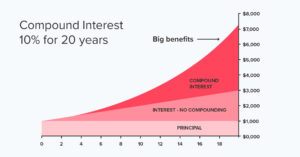
Timeless Investing Rules The Experts Live By (They’re All Based on Long-Term Strategies)
When it comes to investing, you’ll hear a lot of different advice from different people.
Even seasoned and experienced investors will say different things…
…Which means that as a beginner, it can often get confusing to understand what is right and what isn’t.
Having said that, there are 5 investing rules that most investors will agree on — so we’ve curated a list of the most useful rules to live by that you can follow when you start to invest.
1. Spend less than you earn
It may sound obvious, but many of us struggle to keep our spending within budget — especially when we don’t make an effort to save first.
Spending less than you earn is the key to having disposable income: that leftover money in your bank after taxes, bills and general living expenses are taken care of. It’s the income that can contribute to your investments and build wealth.
But in practice, it can be difficult to spend less than you earn. That’s partially due to Parkinson’s Law: work expands to fill the time allotted to it. The same goes for money, since you’ll always find something else to spend it on.
One of the best ways to tackle this issue is to pay yourself first: the minute you receive your salary or income, take out 10% and send it to your savings accounts. If 10% is too high, start with 1% — and then work your way up.
Once you’ve taken out your savings, you’re allowed to spend whatever’s left, as you’re already done with saving!
That’s the trick to spending less than you earn.
2. Be patient
Most investments won’t just blow up overnight.
Asset classes such as the stock market or P2P investing rely on compounding interest to deliver higher returns. It means that the majority of your returns will come later on in the investment period, and patience is therefore key.

Some investors believe in ‘timing the market’. This refers to the studying of market cycles and investing based on historical data, usually when the markets are volatile.
But trying to ‘time the market’ is a risky strategy (like gambling) — especially considering that 95% of investment managers don’t beat the market.
Imagine investing €200 monthly at 6% annual interest (compounded) for 20 years. Your investment would total over €88,000 at the end of the investment period, with over €40,000 accumulated in interest.
Now imagine investing the same amount for 40 years.
Sure, that can feel like forever… but the total value of your investment now rises to over €370,000, with over €20,000 in interest in the final year alone.
Being patient helps you earn an additional €283,000!
That’s why they say, “time IN the market beats timing OF the market”.
So be patient with your investments and allow them the time to mature.
3. Don’t put all your eggs in one basket
Diversifying means splitting up your investments into different types of assets in order to reduce risk. If one investment fails, the others should still offer a healthy return. Professional investors use this strategy to protect their overall wealth when there’s a downturn.
But how do you diversify as a new investor?
First, look for assets that don’t overlap. For example, those in different industries or markets. ETFs are a good option for those looking to invest in an automatically managed diversified portfolio. This helps protect your investments from unsystematic market movements.
Second, choose different classes of asset. For example, it’s worthwhile to hold some gold, invest in P2P lending and invest in property (through REITs). This way, you can also avoid the systematic market crashes that sometimes occur in the stock market.
Let’s say you have €1000 to invest every month.
Here is one way to split up your investments:

Diversifying means that you’ll lower the value of each individual asset, but that overall you stand the chance of making higher returns. Consider sticking to one investment route first, and then adding a second after 6 or 12 months.
(Those who diversify with Swaper can expect to make 14% annual returns, which is approximately double the rate at what typical stock market returns provide).
4. Invest regularly, and long-term
Research shows that emotions (and short-term thinking) cost investors quite a lot.
In fact, negative emotions correlate with negative investment returns across the board. And no wonder: if you invest your savings and then see the market tank, it’s likely you’ll be tempted to sell your investments.
That’s why we’re big fans of “dollar cost averaging”: investing a small amount of money every month, instead of doing it all in one go. By committing to invest the same amount every month, you’re less likely to feel the bumps and essentially turn investing into a habit.
Remember those savings we mention in rule #1?
The minute you get your income, setting aside 10% and putting it into investments is one of the best ways to ensure you spend less than you earn while also getting in the habit of investing regularly.
5. Keep fees low
Think about a 2% fee? Sounds like nothing, right?
Why even waste your time worrying about a measly two percent?
Fees are one of those things that seem small, but will accumulate over time.
Let’s see how it works:
If you invest €1,000 for 20 years with a 10% annual return, you’ll get close to €7,000 (with no additional investments). But if you’re paying 2% in fees, that 10% annual return quickly drops to only 8% (10% minus your 2% = 8%). So, that €7,000 you were expecting after 20 years? It’s now less than €5,000.
That measly two percent will end up costing you more than €2,000 over a 20 year period.
Fees eat into your overall investments, with no real upside.
The final investing rules most investors live by?
Never pay more than 1% in fees.
At Swaper, we don’t believe in charging any fees which also means that selling your loans on the secondary market is free.
Conclusion
These are 5 investing rules that every sound investor follows.
They’re not sexy, but that’s what investing should be: boring, consistent and delivering results. And then when you need the money for your child’s education, travel or retirement, it’ll be there waiting for you. That’s what investing is really for.
Looking for an investment class that aligns with those investing rules?
Try P2P investing. You can set up a new account in minutes.
